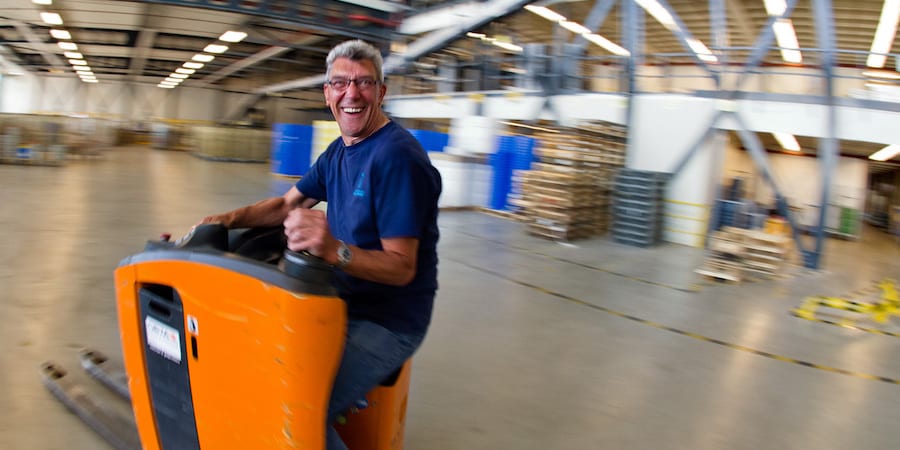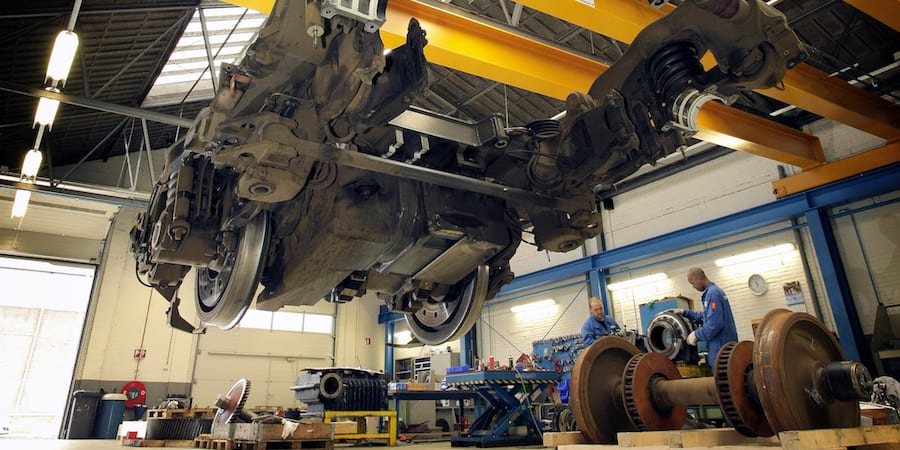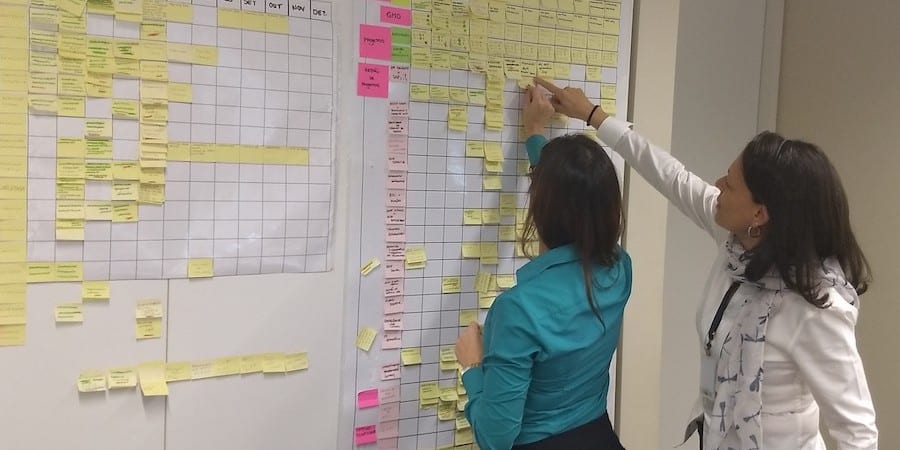
Revolutionizing warehousing in a hospital with lean thinking
FEATURE – The warehousing department of a Dutch hospital has been implementing lean for a few years. Its Head of Logistics believes in an approach to change based on respect for people and on making small but steady steps.
Words: Jonny Mooi, Head of Logistics, UMCG Eemspoort; with Wiebe Nijdam, Director, Lean Management Instituut
I joined the Logistics Center Eemspoort at the end of 2007, six months after the University Medical Center Groningen and the Martini Hospital opened the new 5,000-sqm warehousing facility. Because the same space is used to store and distribute supplies for the two hospitals, I immediately thought that if we wanted to be able to effectively work together and professionalize the way we work we would have to change the way we did things. We needed a different way of thinking.
Back then the floor was a mess. It was clean – don’t get me wrong – but a mess nonetheless. I wanted to tackle that first, and I googled “workplace organization” hoping to find something helpful. 5S popped up in the results, and I started to read about it. That’s when I first heard about lean and the Toyota Way. “That’s impossible. We will never be able to do it,” I thought to myself. Yet, when I saw the Lean Management Instituut offered a course – the Lean Professional Course – a colleague and I were quick to join.
At first, it looked like it would be very difficult to get our 40 people on board. They were showing doubt and reluctance. For years, the culture of the organization had taught them that in the hospital it is those who wear white who make the decisions, whereas in a warehouse it is the blue uniforms running the show. There was a lot of hierarchy, no collaboration, and no understanding of what others in the organization do. I wanted to change that: everybody would soon know about each other’s work and learn to collaborate.
The warehouse may have been in a new building, but the culture was still very much tied to the old ways. We were experiencing what I like to call “ad-hoc-racy”: every day we’d do something different, based on our opinion on what had to be done rather than on hard facts. Employees were not encouraged to think; they were simply asked to do what they bosses told them to do. Instead, I wanted them to use their ability to think and to understand it was now safe for them to change things, to come up with ideas, to make suggestions and to improve the processes that were not working.
We started on our own with small, but very practical experiments. I guess this is what people mean when they talk about “bottom up”. We began with changing a few processes in the area where we receive goods, asking people for suggestions. We did not get angry when results failed to come in, and made an effort to always highlight the lessons learned from the failed attempts to improve. I wanted people to understand we recognized their contribution and that we were giving them the space to try.
Even though I had read books and completed the Lean Professional Course, I still had no coach supporting me full-time (although the help I got from the Lean Management Instituut was truly invaluable) and found myself fighting against 30 years of traditional thinking that had influenced my behaviors as a leader. I had to find a way to change myself if I wanted everyone else to do the same.
The most critical lesson that lean taught me is that everything I thought I knew – all of my assumptions – was wrong! For 30 years I had worked in a culture (the one most organizations work with) that taught me I was the boss and that problems were the employees’ fault. I had to relearn how to be a leader, and recognize that I may have been the boss, but that I was also the problem.
I wanted to be someone who is able to inspire and guide people, encourage them to embrace their craftsmanship to always improve, empower them to overcome obstacles and achieve better outcomes for themselves and our customers. People must go home every day and feel good about the work they have done. They need to know there is value in what they do. And they need to feel proud, safe and fulfilled.
A FEW EXAMPLES OF CHANGES
Of course our processes changed a lot since lean was introduced – a huge part of making people feel fulfilled is enabling them to carry out fulfilling work.
One of the most significant improvements entailed rationalizing the way we archive medical records and collect them when doctors need to look at them for a follow-up visit or for a customer who comes back. We used to receive lots of complaints, but by involving all the professionals taking part in the process and communicating better with our (internal) customer, we managed to dramatically change things. We noticed that we were doing two runs a day even though we did not need to.
Another big change was in the way we receive goods, sterile and non-sterile disposables, office supplies, food, and so on). At the end of process, goods go to the customer and information goes to the finance department so that they can pay the bills. We used to have questions from the finance department all the time, which resulted in bills piling up. Again, by talking to the finance people we were able to understand how to improve our process so that they wouldn’t have to ask as many questions as they used to. The answer to that was, unsurprisingly, flow: open the box, check the bill, open the PO, etc. We started to work as a unit, with each person responsible for one part of the process.
Both of these changes were great successes precisely because the suggestion to make them came from people themselves and the implementation was carried out by them.

THE REAL CHANGE IS IN PEOPLE
It’s interesting – and quite wonderful – to see how much people’s behaviors have shifted. Everybody is at the gemba these days (rather than on the phone fighting fires), highlighting problems and analyzing them on the spot. Any problem is everybody’s problem, and the responsibility is shared. The blame culture has left the warehouse – and that to me is what respect for people is all about.
Applying lean principles bottom-up is hard because we have to do it by ourselves, and we don’t have external resources to tap into. On the other hand, this gives us great flexibility, and the freedom to approach change the way we think is best.
In my mind, the most visible change – and the one that gives me more satisfaction – is the pride people have in the work they do here. It is their work, and they want to do it as best they can, as demonstrated by the great performance improvement we have witnessed over the years.
Some of our improvements even resulted in downsizing, but we made sure no one would be laid off. Our people were retrained and given work in support operations or other departments. How can we expect people to change their behavior and get on board if they don’t feel safe? That’s another fundamental part of leading with respect.
SLOW DOES IT

You have to be creative when you go at it alone. Lean is hard work, but things would be much harder without it, wouldn’t they? We are going down the lean path at a slow but steady pace. At every stage I want to make sure people are on board and understand the reasons why we are doing what we are doing. I needed time to learn what lean is (and still do), so the least I can do is give my colleagues the same opportunity. Because I don’t want to simply implement lean, but to change the company’s culture, making sure people understand where we are going – and that it is safe to go there – is of the utmost importance.
Over the years, I have learned that small, incremental improvements are far more effective than fast, big, and disruptive changes. Going slowly, however, requires a good deal of perseverance and discipline, and being disciplined is a choice.
As it happens, I am a taekwondo enthusiast and I remember reading a booklet for taekwondo instructors in which authors Janet Gaultier and Juliette Trãn share what they define as the 10 steps to improve perseverance – a must for all taekwondo (and incidentally, lean) practitioners. I’d like to share them with you, because I think they apply very well to a lean transformation:
- Try it
- Try it again
- Try it another time
- Try to understand why something is not working
- Try it in a slightly different way
- Try it again tomorrow
- Try it again and ask for help
- Try to find somebody who has already done it
- Try it again with the new knowledge
- Keep on trying and testing until it works.
In many a lean transformation, too many things are done at once. At the Distribution Center we are doing lean one step at a time, 100% committed. We only move to the next situation (or problem) once you have fully grasped (or solved) the previous one – the analogy with martial arts here (wax on, wax off – remember?) is very strong. We are going slowly, but this way we ensure our results are more effective and sustainable in the long term.
THE AUTHORS


Read more


FEATURE – A Dutch company that maintains and overhauls train bogies has realized that in order for lean to work, a focus on continuous learning must be established. Here is how they are trying to get there.


INTERVIEW – In this follow-up conversation with the Hospital Moinhos de Vento in Brazil, we learn about the elements that are helping them to make lean stick.


FEATURE – You don’t always need a lot of external help to initiate a lean transformation: the experience of the Emergency Department of the Hospital Clínic of Barcelona shows it can be done with very little support from the outside.


ONE QUESTION, FIVE ANSWERS – With this month’s question we try to understand what lean idea or principle our interviewees would have liked to learn sooner or better in their journey. So, heads up… You might be in a similar situation.

